
Discover the lakes that give the Dolomites their soul and South Tyrol its mystery. These waters have shaped myths, mirrored mountains, and moved countless travelers. Linger by them long enough and you’ll see — beauty may be their beginning, but it’s far from the whole story.
When people dream of the Dolomites, it’s usually the peaks that get the glory. But often the real dazzle lies lower down. Still, ancient, reflective.
Lakes.
And not just any lakes. Lakes that carry stories, losses, legends, and a stillness that creeps under your skin and stays there.
You’ve seen some of these lakes before — on Instagram, in travel mags, maybe on your cousin’s vision board. They’re not all secrets. Some are wildly famous. But popularity doesn’t make them any less powerful. What matters is how you experience them. Because even, the most photographed places still have stories to tell. You just have to stick around long enough to hear them whisper.
By the way, these lakes aren’t ranked. We learned long ago that ranking natural wonders is like rating sunsets… pointless and a little arrogant. Each lake earns its place for different reasons. Some are famous, some hidden. Some easy, some earned. All unforgettable.
1. Lago di Braies | Pragser Wildsee
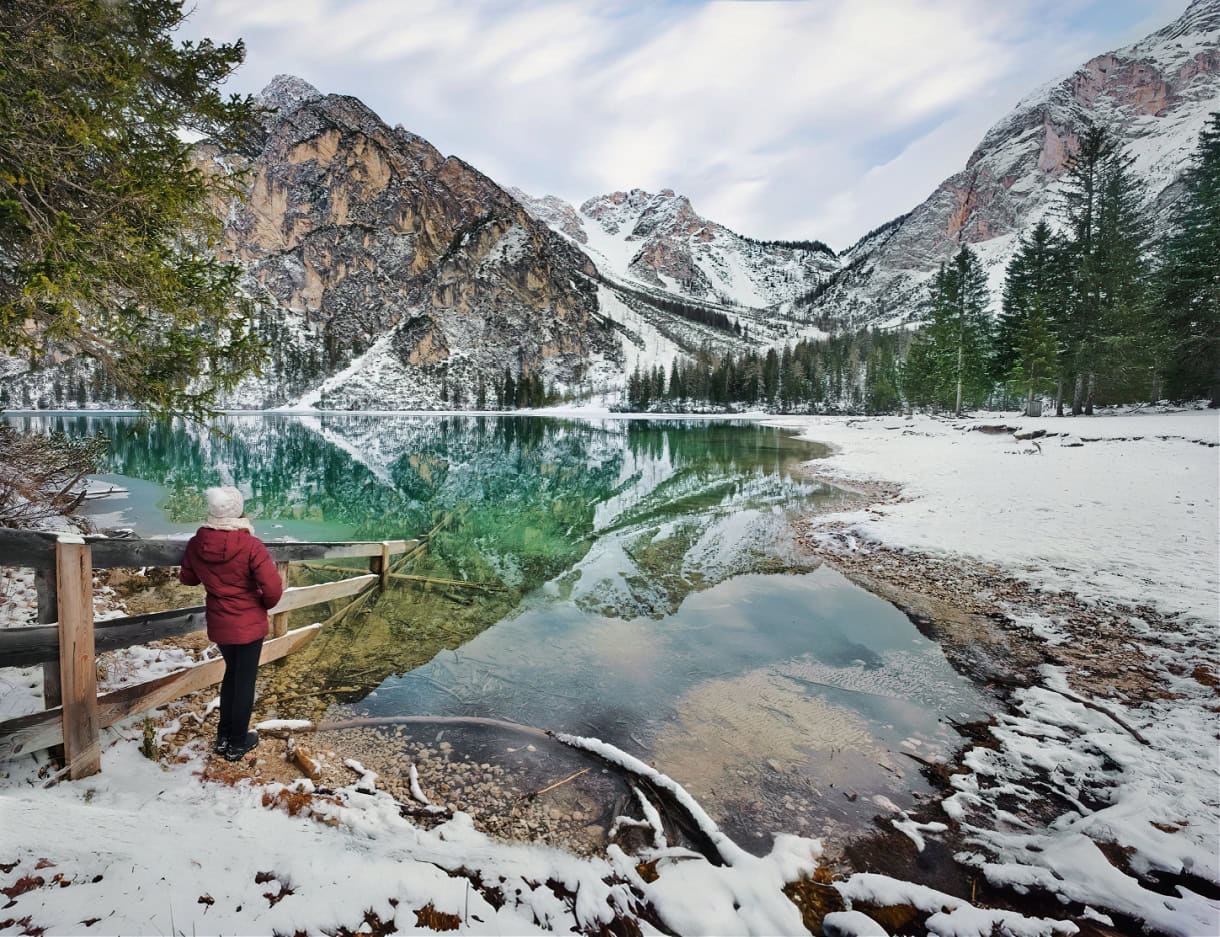
Call it cliché. Call it overexposed. But stand on the shoreline of Lago di Braies at dawn or in the stillness of winter and tell us it doesn’t deserve the fame. The symmetrical mirroring of mountain and sky here is pure magic.
When we first laid eyes on it early one October morning, mist still curling off the water and old wooden boats bobbing like ghosts of another time, we understood why poets and influencers alike have lost themselves here. It’s not about what you see. It’s about what it reflects back.
How to Visit Lago di Braies
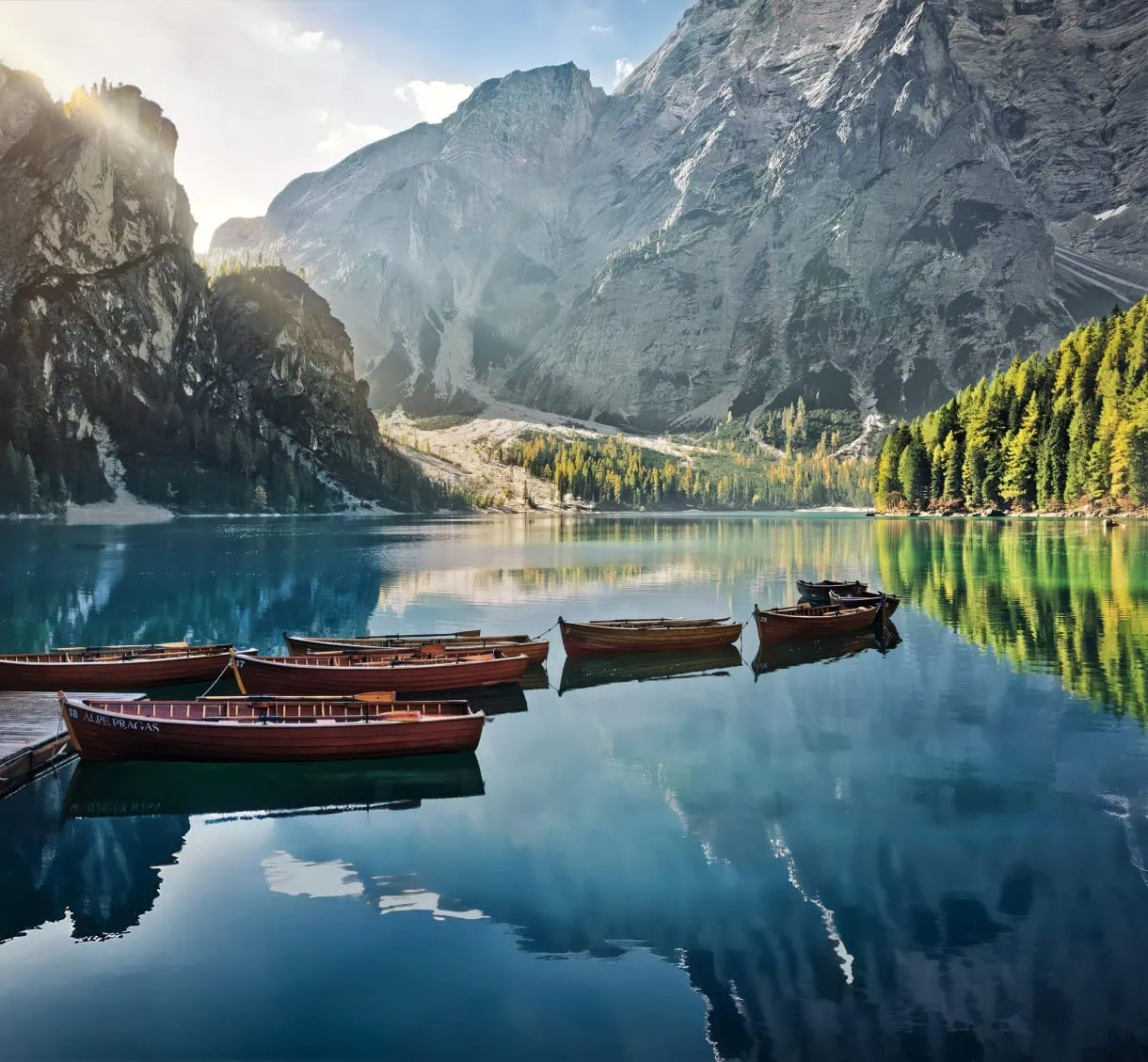
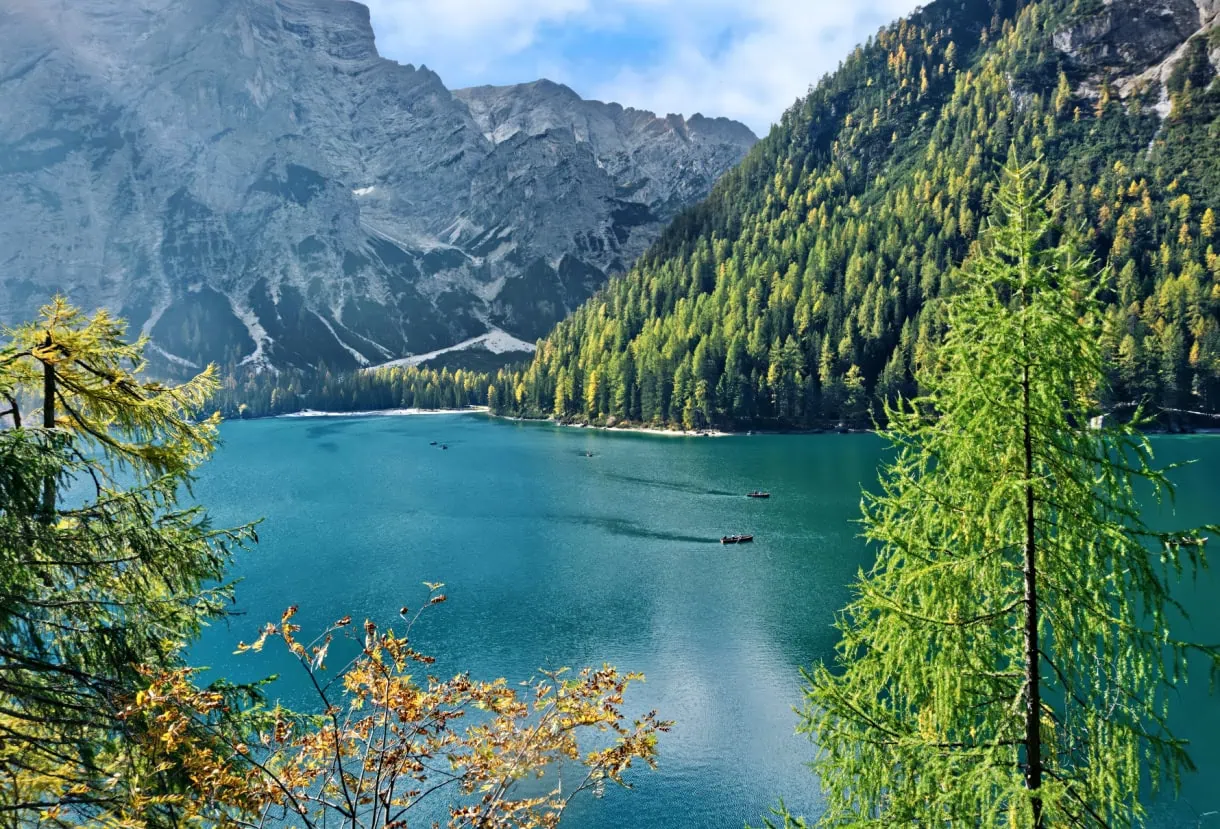
Go early. Like “sunrise-early” to beat the crowds or late in the day when the tour buses have left. The two-mile loop around the lake is straightforward. The northern end has the iconic boathouse; the southern shore is where you’ll find some quiet.
Want a real treat? Hike to Malga Foresta through the Grünwaldtal | Val di Foresta valley for lunch. Our Lago di Braies guide shows you the way.
🧭 Good to Know: If you are visiting South Tyrol’s Christmas markets, consider adding a visit to Lago di Braies to your itinerary. It offers a peaceful escape from the festive bustle. The lakeside trail, running beneath snow-dusted spruces, is a delight to wander from one end to the other. It quickly became one of our favorite winter walks in the Dolomites.
Trip Planning Made Easy: Get our South Tyrol + Dolomites Travel Guide
2. Lago di Carezza | Karesee
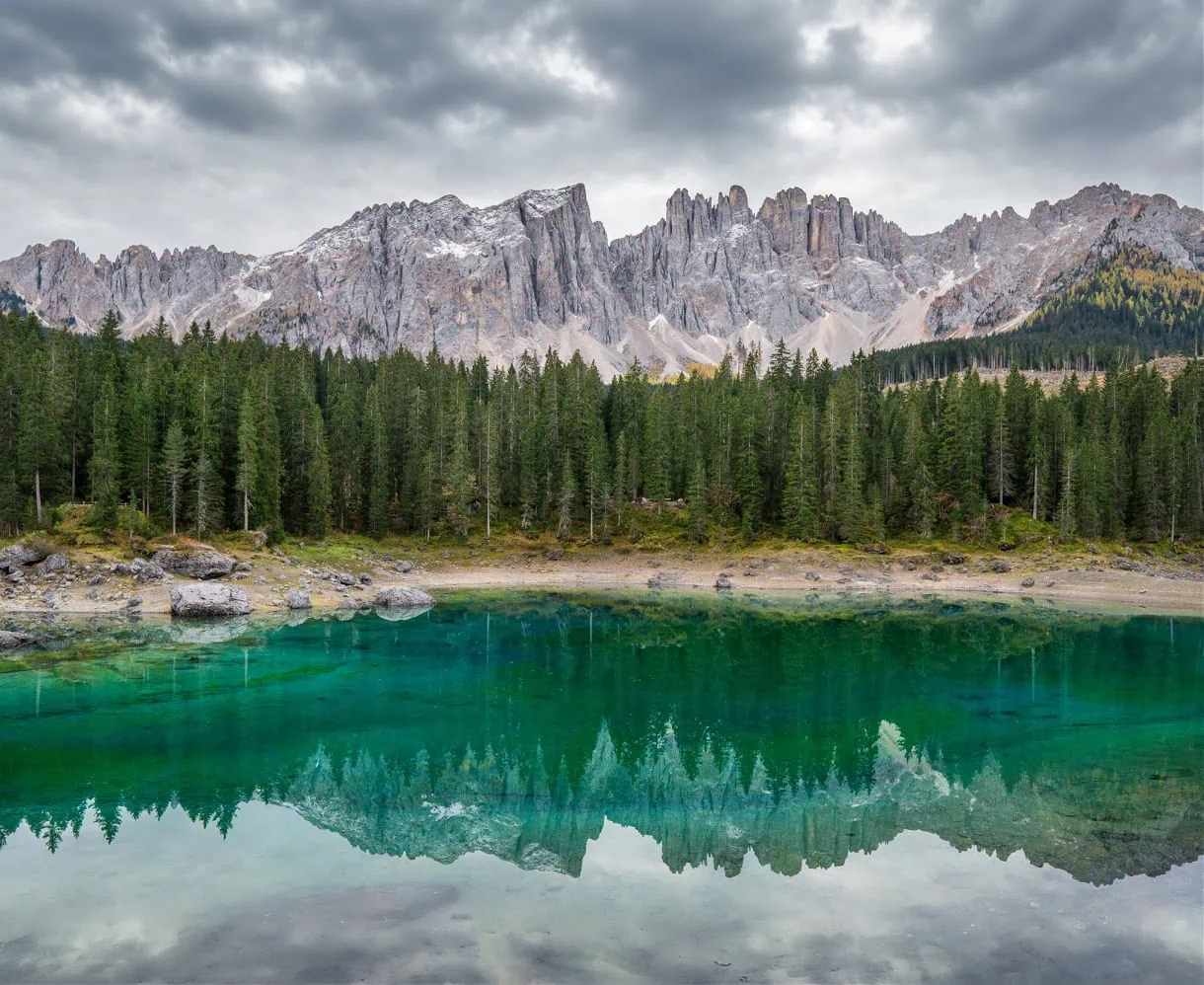
When we saw Lago di Carezza for the first time its shimmering splendor was imprisoned by a sheet of ice. But even then, it cast a spell that made us stop, stare, and forget the cold. A spell broken only by the clamoring of cowbells as a parade of Krampus crashed the shoreline.
The lake’s enchantment found us again when we returned in late summer to admire its its glassy surface, alive now with a thousand shifting hues. Nestled in the forests of Val d’Ega, Lago di Carezza flickers with color like someone spilled a sorcerer’s paintbox into its depths.
Locals will tell you a wizard once tried to woo a mermaid here by tossing a rainbow into the lake. She fled, he vanished, and the colors stayed. Fantasy? Sure. But on the right day, when the light is soft and the pines hush the world, you’ll want to believe it too.
How to Visit Lago di Carezza
A one-mile (1.6 km) trail loops around Lago di Carezza, offering one of the most effortless, and rewarding, short walks in the Dolomites. Framed by spruce trees and wildflowers, the path is steeped in alpine scents and mountain stillness. Each curve in the forest reveals the lake in a new light, its waters shifting in color like a mood caught in glass.
⇒ YOU MIGHT ALSO LIKE: How to Hike Seceda
3. Lago di Landro | Dürrensee

Lago di Landro is easy to miss. We nearly did. It doesn’t scream for attention. It sits just off the road between Dobbiaco and Cortina d’ Amprezzo, quietly stealing glances from passersby on their way to more famous destinations like Tre Cime di Lavaredo and Cadini di Misurina.
But you need to stop. Get out and at a minimum walk along its northeastern shoreline. The lake’s shallow waters reflect the craggy face of Monte Cristallo, a brute of a mountain with a crown of sawtooth spires gnashing at the clouds.
How to Visit Lago di Landro
A 2.8 mile (4.5 km) trail sweeps all the way around Lago di Landro, making it another effortless way to visit the Dolomites. Autumn is especially stunning. The whole scene turns into a painting. Parking is located right off of SS51 next to the lake.
🧭 Good to Know: History buffs take note: Lago di Landro was a front line during World War I. Monte Piano and Monte Piana roar above the eastern shore. On these summits, deadly close-quarter battles took place where the Italian and Austrian forces were at times less than 10 feet apart.
4. Lago di Sorapis
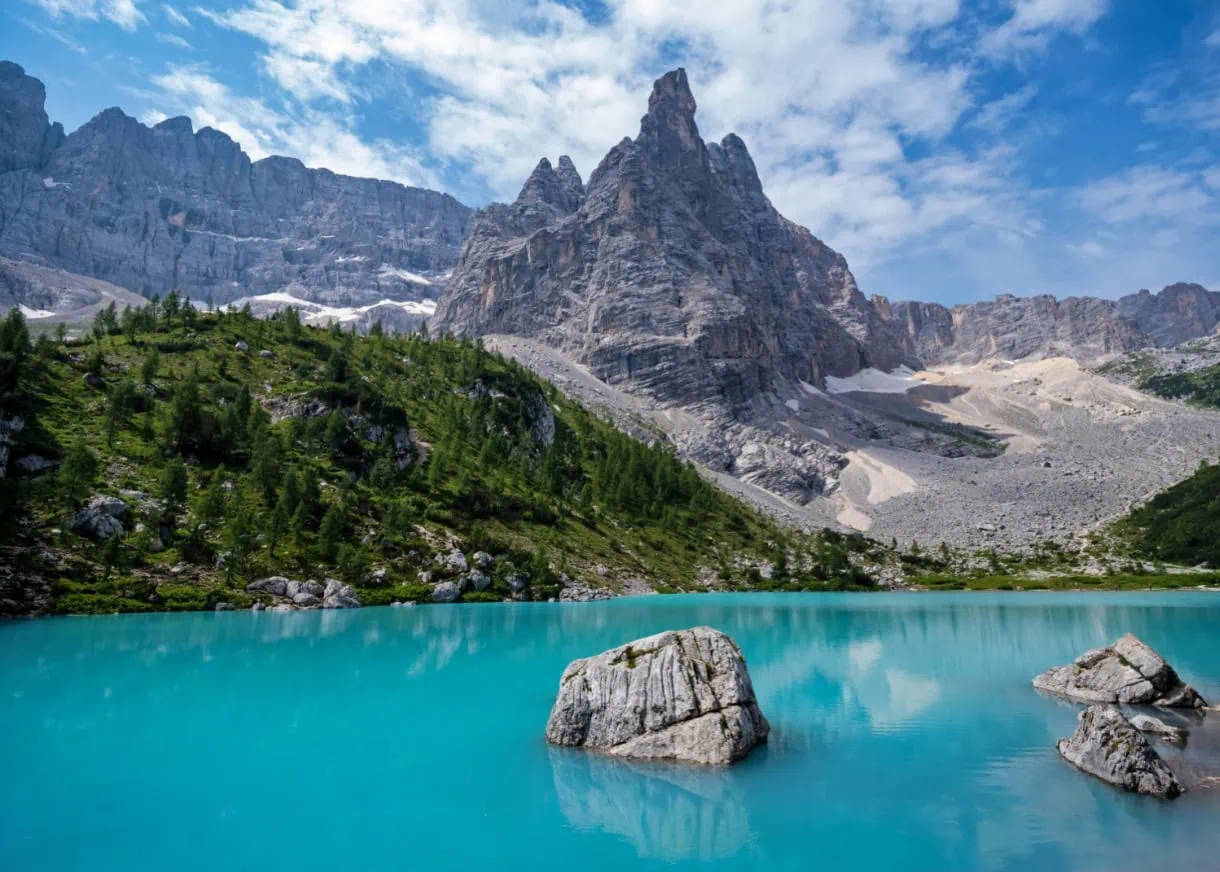
Lago di Sorapis is the stuff of alpine … and Caribbean dreams. Located in the Sorapiss Group, just 45 minutes south of Cortina d’Ampezzo, it’s a surreal turquoise basin cradled high in the Dolomites like a secret elixir spilled by the gods.
Surrounded by sheer rock walls and glacial cliffs, this lake is no roadside attraction. You have to earn it. But once reached, its milky-blue glow and unearthly stillness will hush the fire in your legs. It’s incredible blue color comes from glacial “rock flour” (fine silt) suspended in the water.
How to Visit Lago di Sorapis
Start the 8-mile round-trip hike to Lago di Sorapis from Passo Tre Croci, just outside Cortina d’Ampezzo. Arrive early for parking or take the bus. The trail begins in forest, climbs gradually, and includes sections with steel cables and narrow ledges. It’s well-secured, but a hike you may want to reconsider if you do not have a head for heights or especially if you polished off two bottles of Lagrein the night before.
🧭 Good to Know: Lago di Sorapis shrinks dramatically by late summer and autumn. We learned this the hard way in October, when the “lake” was little more than a pale pool surrounded by rock. Because it’s fed almost entirely by snow and glacial melt, its water level drops once the summer thaw ends. Visit between late June and August to see the lake full and glowing in its signature hue.
⇒ YOU MIGHT ALSO LIKE: Cadini di Misurina: How to Visit the Epic Viewpoint
5. Lago di Vernago | Vernagt SEE

You don’t stumble upon Lago di Vernago (Vernagt See). You seek it. High in Val Senales, the lake lies flanked by thick forests and timeworn trails that snake up to some of South Tyrol’s highest alpine farms. It’s not a showoff. It’s a place of quiet strength. Where tradition endures in breathtaking isolation, and where crowds rarely wander.
We found the contrasting scenery here fascinating. On one side, dense evergreen forest. On the other, sun-drenched meadows where goats chew lazily, with not another soul in sight. Between them lies the deep blue lake. Serene, still, and dividing two worlds. And above it all, the glacier where Ötzi the Iceman was found peers down like a watchful ancestor.

How to Visit Lago di Vernago
Pick between a 4-mile ( 7 km) circuit trail tracing the shoreline or a more challenging circuit that runs nearly 6 miles (9 km) and leads you high above the lake. Up here, be sure to visit the historic Finailhof for a meal made from what’s grown and tended to on the mountainside.
🧭 Good to Know: While exploring Lago di Vernago, carve out time for Iceman Ötzi Peak — arguably the most storied summit in the Alps. From this breathtaking perch, you’ll gaze across the windswept wilderness where Ötzi was discovered, entombed in ice for over 5,000 years. The cable car to the summit departs from Maso Corto, just a quick 10-minute drive from Lago di Vernago.
6. Lago di Dobbiaco | Toblacher SEE

Not every lake in the Dolomites dazzles with drama. Some simply stir you gently. That’s why Lago di Dobbiaco is one of our quiet favorites. A place we love to visit after hiking Tre Cime di Lavaredo.
Like Lago di Landro farther south, this lake is easy to overlook when rushing between Dobbiaco and Cortina d’Ampezzo. But if you slow down, you’ll find it peacefully stretching between two mountain ranges, long and low, surrounded by larch and spruce.
It’s where composer Gustav Mahler came to escape and write his masterpieces. And you? You come here when you need to let your thoughts settle like silt in deep water… and perhaps that novel that you been meaning to pen will rise to the surface, page by page.
How to Visit Lago di Dobbiaco
Enjoy an easy stroll on the lake’s 1.5-mile (2.5 km) loop trail. Late in the day, its waters often reflect a sky streaked with gold and lavender that rivals the scenes of the day. That kind of view delivers a dose of alpine wellness. No spa reservation (or steep bill) required. Parking is located right off of SS51 next to the lake.
🧭 Good to Know: A bird-loving nature preserve hugs part of the shoreline, making it a wonderful spot for observation and photography. For a closer connection with the lake, you can also rent pedal boats and glide from one end to the other. But keep in mind, swans have the right a way here.
7. Lago di Resia | Reschensee
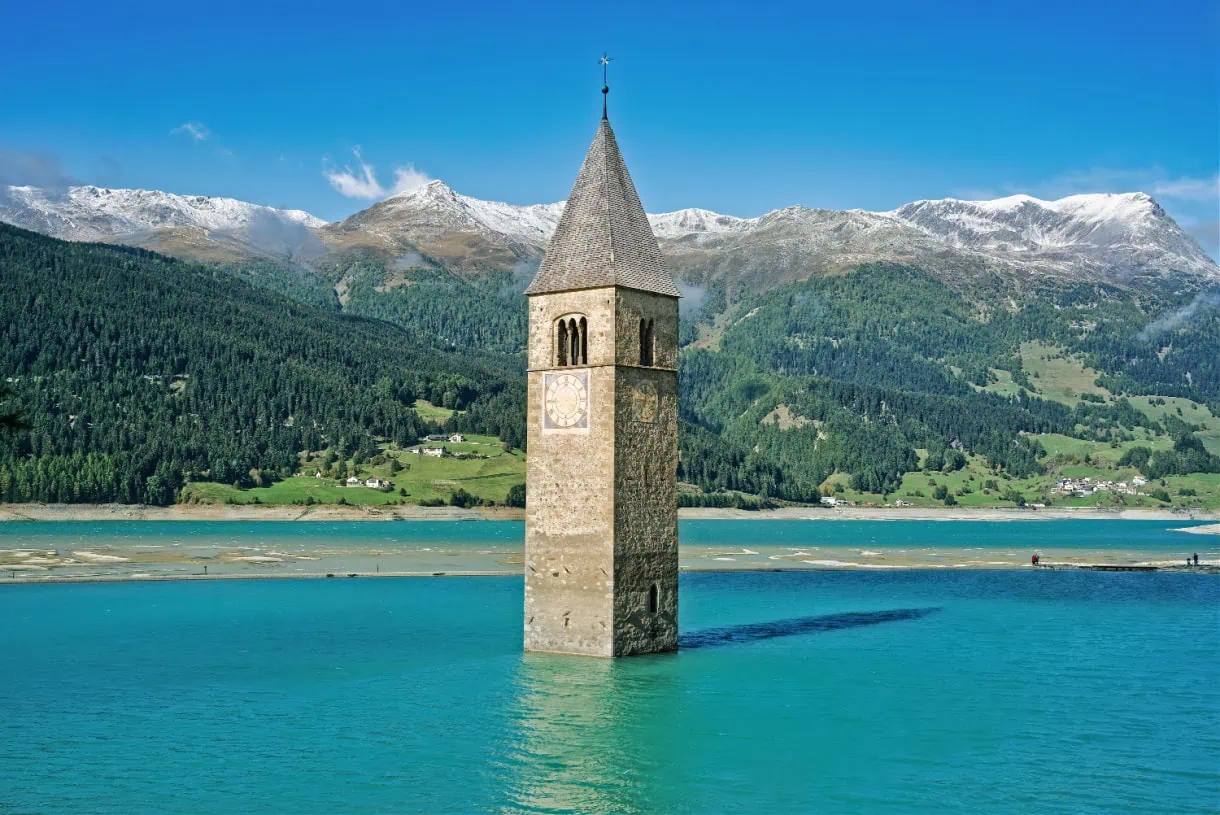
Imagine standing on the edge of a turquoise lake, wind biting your cheeks, and out in the water — a bell tower, alone, rising from the depths like a ghost’s middle finger to history. That’s Lago di Resia. A manmade lake built on sacrifice. A village drowned. Lives uprooted in the name of progress. And all that’s left to mark it is stone, silence, and the ringing you swear you hear… even though the bells were removed decades ago.
This isn’t just one of South Tyrol’s most surreal sights. It’s one of its most haunting. The lake was formed when the valley was dammed in 1950, flooding the village of Curon. Over a thousand people were forced to leave, and their homes were swallowed whole. All that’s left above water is the 14th-century bell tower, now one of the most photographed ruins in the Alps.

How to Visit Lago di Resia
After admiring the haunting silhouette of the Curon bell tower, walk or bike the 9-mile (14 km) trail that loops around the lake. Come early, when morning fog drifts across the water, or visit in winter when the lake freezes and the tower looks like it’s marching across the ice. In autumn, we stayed in a cozy Tyrolean hunting lodge tucked into the forested slope above the lake— it made for a perfect base to explore the entire area.
🧭 Good to Know: Unlike most of South Tyrol’s postcard-perfect lakes, Lago di Resia is equal parts beauty and action. It is a great destination to enjoy everything from kayaking and pedal boating to kitesurfing and windsurfing.
8. Lago di Misurina | MISURINA SEE

Lago di Misurina is the largest natural lake in the Dolomites. Located just beyond South Tyrol in Cadore, a mountain district of Belluno, it glints like a blade beneath some of the Dolomites’ most iconic peaks, including the Three Peaks, Mount Sorapiss, and the Cadini di Misurina.
But this lake is more than a shimmering gem in the Dolomites’ rugged crown. Thanks to its rare microclimate, Misurina is known for its remarkably pure air — so much so that visitors have long sought it out for its restorative effects. For centuries, people have come here not just to admire the scenery, but to breathe deeply and let the mountain winds work their wonders.
How to Visit Lago di Misurina
Lago di Misurina is a place to wander slowly. Early in the morning or late in the day is when we’ve found it the most beautiful. A flat, well-maintained 1.7 mile path encircles the lake, perfect for an easy stroll with panoramic views at every turn. In addition, you can rent a paddle boat and drift across the water, watching the mountains ripple in the reflection, or stop at one of the lakeside cafés for a slice of apple strudel and a front-row seat to the scenery.
9. Lago di Fiè | Völser Weiher
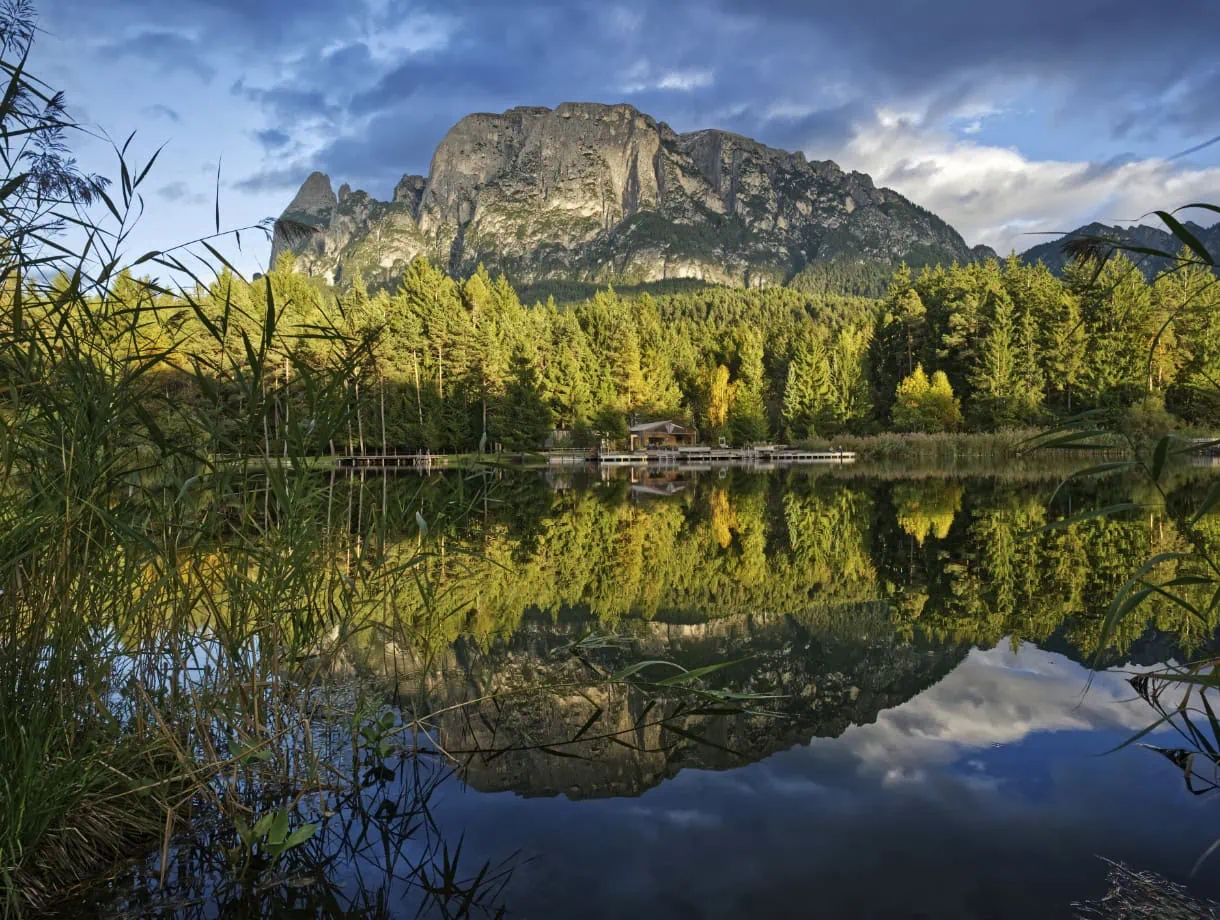
A world apart from the dramatic grandeur of larger lakes, Lago di Fiè is a serene beauty tucked at the foot of the Schlern massif. It beams just the below Tuff Alm and the Alpe di Siusi plateau. The lake’s charm lies in its intimacy: a small, spring-fed gem cradled by meadows and trees, with the rugged walls of the Dolomites rising like a stone theater behind it.
Like Lago di Dobbiaco on the other end of the Dolomites, we love ending a long hiking day with a peaceful loop around its shores. Every time we’ve visited, we’ve had the lake nearly to ourselves.
How to Visit Lago di Fiè
Take a relaxed walk around the lake, then settle in with a book on one of the wooden bathing platforms. In summer, Lago di Fiè becomes a popular swimming spot with some of the clearest waters in South Tyrol. Residents of Bolzano have flocked here for centuries to escape the valley heat. There’s also a small rowboat rental and a charming lakeside tavern perfect for a relaxed lunch under the larches.
10. Lago di Caldaro | Kalter See
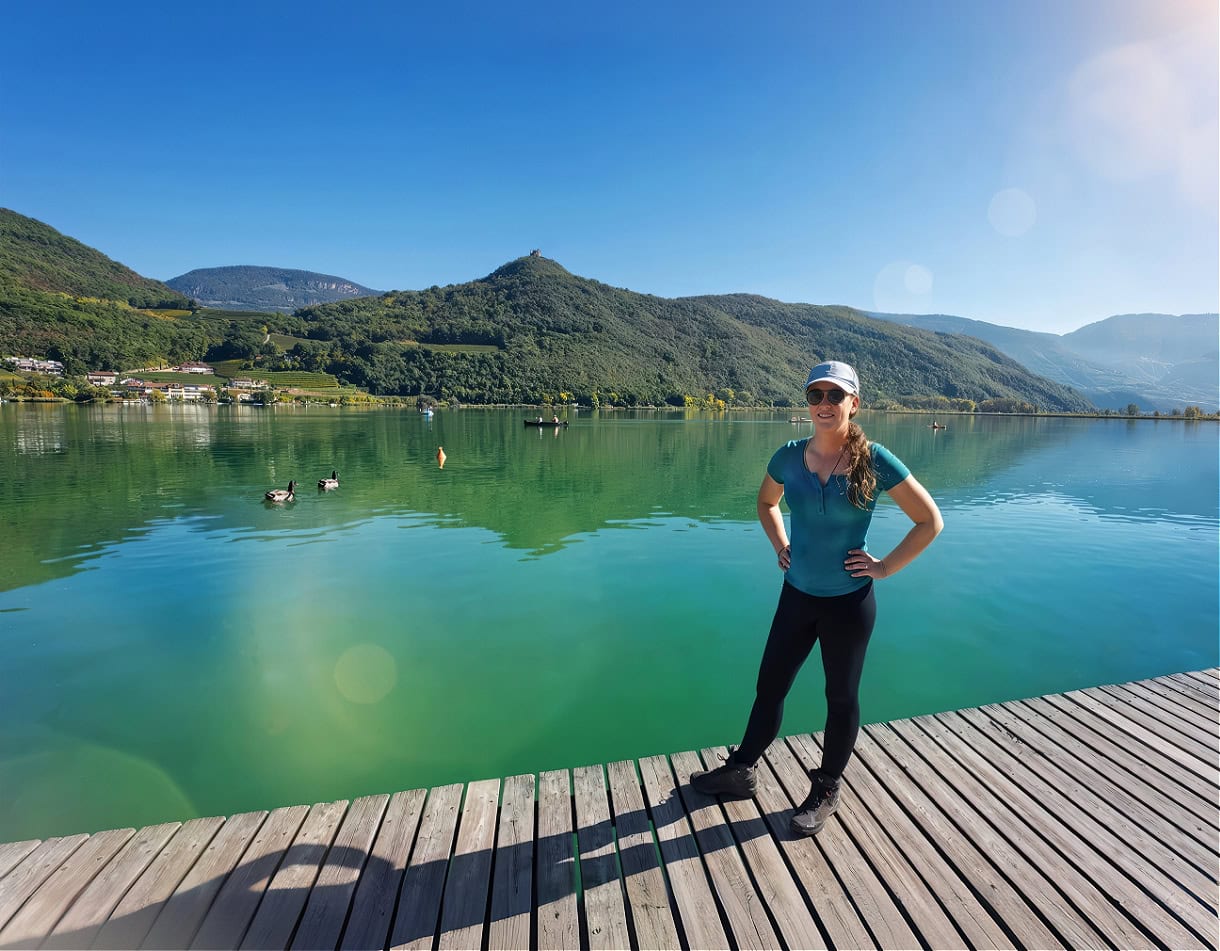
Lago di Caldaro isn’t your typical mountain lake. You won’t find spruces and pines lining its shores. Instead, think sun-drenched vineyards, cypress trees, and hillside villas.
As the warmest lake in the Alps, it offers a completely different vibe. It’s buzzy. It’s got windsurfers, wine bars, and plenty of people wearing everything but hiking gear. We once heard someone call it “the Mediterranean’s lazy cousin who moved north but kept the party spirit.” Hard to argue with that.
Surrounded by South Tyrolean wine estates, Lago di Caldaro draws locals, families, couples, and anyone chasing a little more dolce vita while visiting the Dolomites.
How to Visit Lago di Caldaro
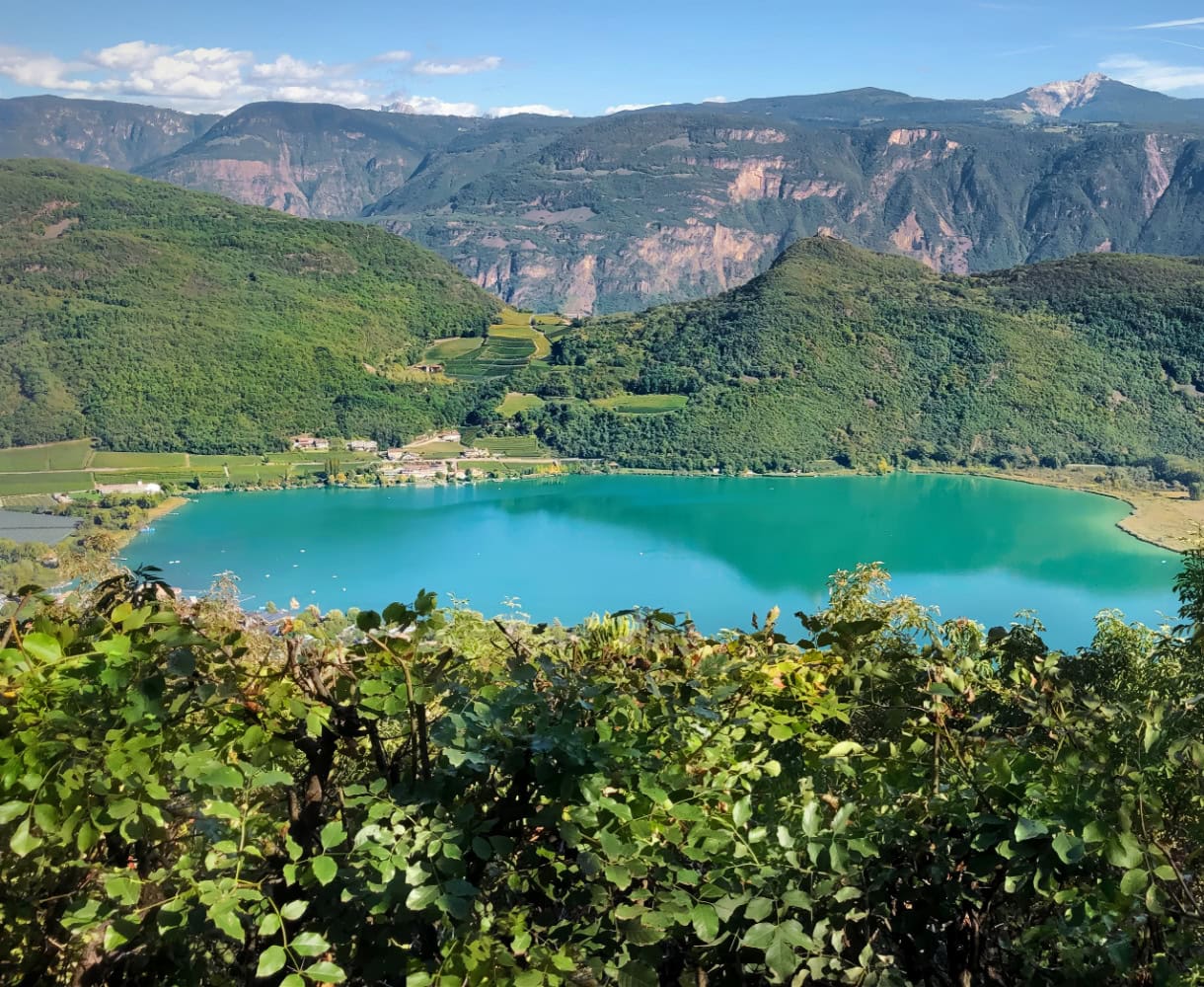
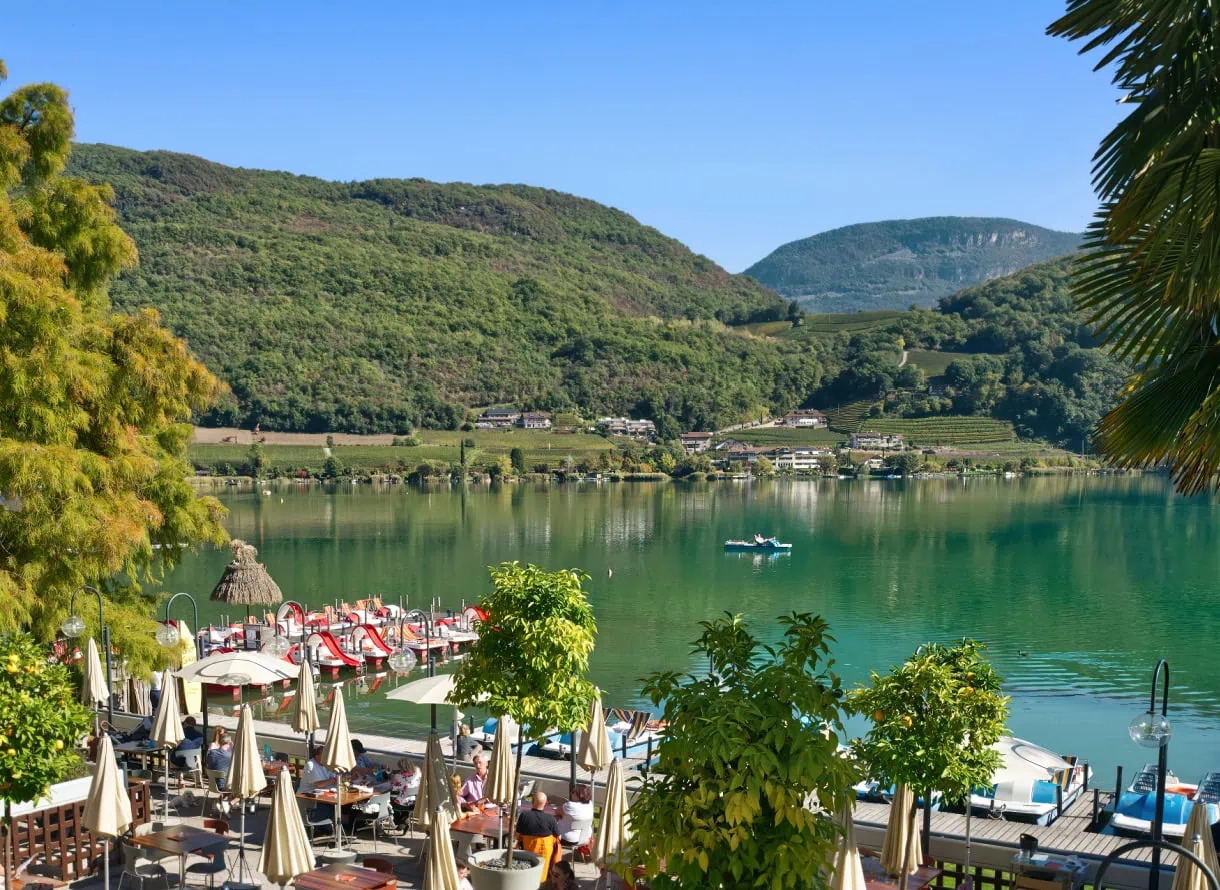
Lago di Caldaro sits right along the South Tyrolean Wine Road, making it a delightful stop between winery visits. There’s a trail that circles the lake — a casual stroll we’re sure is lovely — but truth be told, we’ve never made it past the first row of bars and restaurants near the parking area.
They’re perfect for kicking back with a Hugo in hand, soaking in the sun and scene. If you’re feeling more active, take a dip from one of the docks or rent a pedal boat and drift across its waters.
🧭 Good to Know: Not far from Lago di Caldaro, to the north in the wine‑region of Appiano sulla Strada del Vino (Eppan), lie the two serene glacial lakes of Lago Grande di Monticolo and Lago Piccolo di Monticolo — together known as the Monticolo Lakes. While we haven’t visited them ourselves yet, they both appear gorgeous and offer a quieter, forest‑fringed alternative in South Tyrol’s Wine Country. A network of trails connects the two lakes, making them a relaxed add‑on to your day amid the vineyards.
11. Lago di Anterselva | Antholzer See
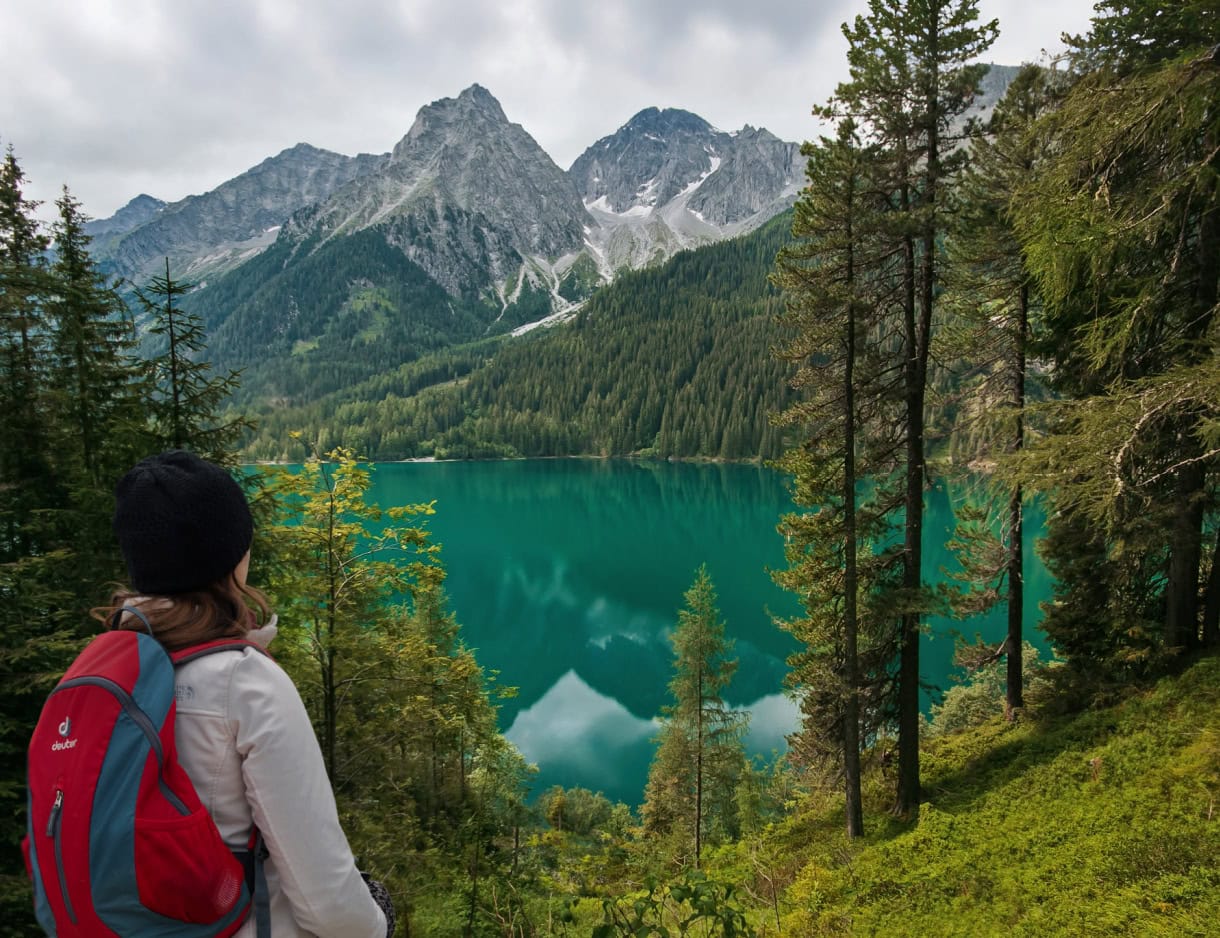
We found Lago di Anterselva the old-fashioned way: by tracing our fingers across a map in search of the mighty Burg Taufers. But before we landed on the castle, our fingers paused on a slender sliver of blue tucked deep in a forgotten valley near the Austrian border. The name alone was magnetic — like a mystical prog-rock band, part Led Zeppelin, part Opeth, all atmosphere.
Cradled at nearly 5,400 feet (1,646 m), this is South Tyrol’s third-largest lake. In fact, you could fit both Lago di Braies and Lago di Carezza within its shimmering shores. Surrounded by pine forests thick as midnight and air so crisp we’re still scheming how to bottle and sell it, Anterselva feels untouched.
Like many of South Tyrol’s lakes, legends lurk in its depth. Supposedly it holds a sunken castle and brims with sorrowful spirits. But honestly, feeling sorrowful here would take some effort.
How to Visit Lago di Anterselva
Set deep in Valle Anterselva — a side valley off Val Pusteria — the lake is wrapped by a peaceful 2.5-mile (4 km) nature trail, lined with info panels if you’re in the mood to learn. If not, just walk. Let the Alps do their work. Then grab a seat at the lakeside inn and raise a glass to the roads less traveled… and the joy of paper maps.
🧭 Good to Know: The serene valley around Lago di Anterselva is about to make Olympic history. Valle Anterselva will host the biathlon competitions during the 2026 Winter Olympics. The venue, known as the Anterselva Biathlon Arena, has hosted six Biathlon World Championships and annual World Cup events, and will welcome athletes from across the world for 11 Olympic biathlon medals.
12. Lago dei Piani | Bödenseen
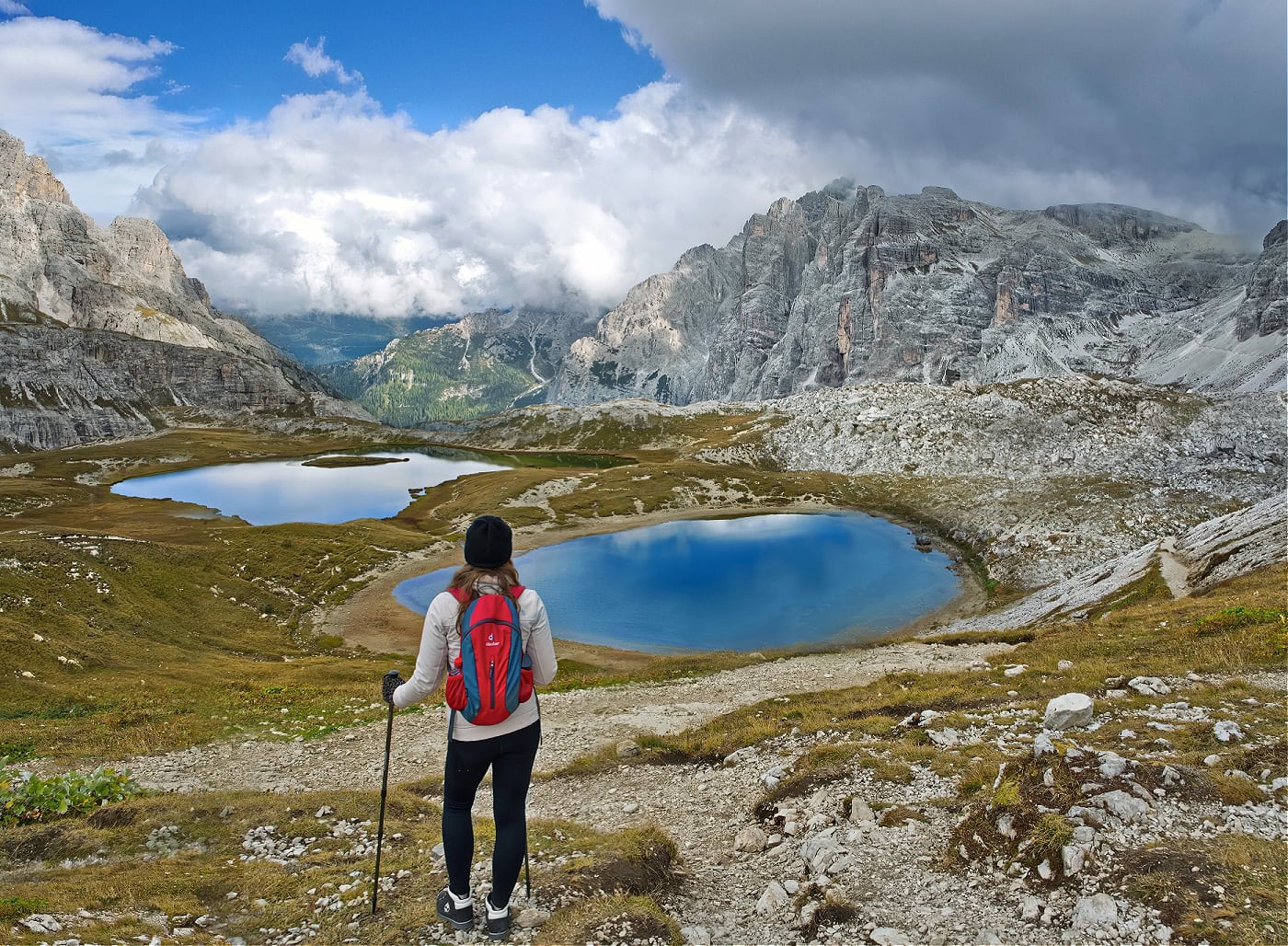
The first time we laid eyes on Laghi dei Piani, we weren’t even looking for them. We had no idea they existed — just stumbled upon them after passing Rifugio Locatelli (Dreizinnenhütte). But there they were: twin alpine mirrors tucked beneath the battlements of Tre Cime di Lavaredo, reflecting the sky so perfectly they looked less like lakes and more like portals to another world.
When we returned later — after visiting Tre Cime’s iconic cave viewpoints — the lakes had vanished into a swirling shroud of cloud. Gone were the bursts of blue and still reflections. In their place: a brooding wall of gray. It was eerie how quickly they disappeared, as if the mountains had swallowed them whole.
There’s no legend of sorcerers or witches here that we’re aware of… but standing in the mist, you might start one of your own. These lakes may not be mythical, but they are, undeniably, enchanting.
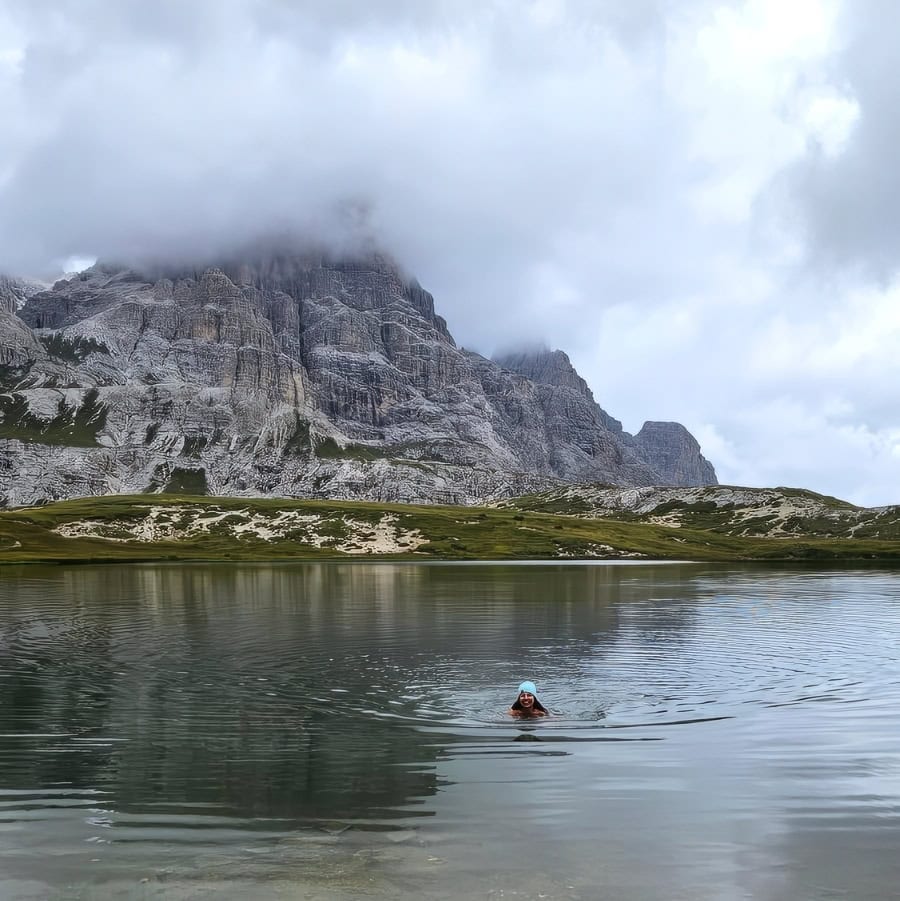
How to Visit Laghi dei Piani
From Rifugio Auronzo, follow the Tre Cime loop trail toward Rifugio Locatelli. Just behind the hut, a short path leads to the lakes. You can circle both for a closer look. If you’re brave (like one of our clients, Lisa Zraket), you can even take a dip. But we’re certain the icy water will leave no part of you un-awake.
🧭 Good to Know: Another glimmering glacial gem to visit while hiking Tre Cime, is Lago Antorno. This small lake reflects the southern faces of the Three Peaks. It sits right along the toll road to Rifugio Auronzo.
Trip Planning Made Easy: Get our South Tyrol + Dolomites Travel Guide
Which Lake Will Speak to You?
In writing this post, we wondered just how many lakes there are in the Dolomites and South Tyrol. Turns out South Tyrol alone is home to 176 natural lakes. Trentino adds nearly 300 more, and when you include the waters scattered across the Belluno and Friulian Dolomites, the tally climbs past 450 alpine lakes. That’s not a list — it’s a lifetime!
So no, this guide isn’t an exhaustive round-up of Dolomites lakes. It’s simply a collection of twelve lakes to inspire, not overwhelm. Think of it as a starting point for your itinerary, your curiosity, or your next great pause.
Whether you crave reflection or refreshment, stillness or soul-stirring views, there’s a lake here waiting to meet you in the moment. One that won’t just give you something to look at, but something to carry with you home.
⇒ READ NEXT: Val di Funes: The Dolomites’ Most Enchanting Valley